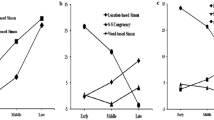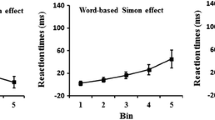Abstract
Two experiments examined whether the location-based Simon effect and word- or arrow-based Simon effects, and their interaction, emerge in the same task situations by presenting location words 左 and 右 (left and right, Experiment 1) or single-headed arrows (left and right pointing, Experiment 2) in the left–right visual field. These tasks include two attributes of task-irrelevant location information, physical location and either location word (Experiment 1) or arrow direction (Experiment 2), when they vary jointly for a single stimulus. Moreover, the location-based Simon effect in these tasks was compared to that obtained in a pure location-based Simon task. Results showed that (1) the location-, word- and arrow-based Simon effects occurred on both mean RT and delta plots; (2) the word- and arrow-based Simon effects interacted with the location-based Simon effect on mean RT; (3) the Simon effect in the pure location-based Simon task differed little from the location-based Simon effect in the two joint Simon tasks. These results indicate that different task-irrelevant spatial attributes can influence responses in the same task, and that one of them can influence the effect of the other on responses. This latter result offers evidence that the different attributes do not provide separate sources of activation.


Similar content being viewed by others
References
Ansorge, U., & Wühr, P. (2004). A response-discrimination account of the Simon effect. Journal of Experimental Psychology: Human Perception and Performance, 30, 365–377.
Baroni, G., Pellicano, A., Lugli, L., Nicoletti, R., & Proctor, R. W. (2012). Influence of temporal overlap on time course of the Simon effect. Experimental Psychology, 59, 88–98.
Bundesen, C. (1991). A theory of visual attention. Psychological Review, 97, 523–547.
Carpenter, R. H. S. (1988). Movements of the eyes. London, UK: Pion.
Cohen, J. D., Dunbar, K., & McClelland, J. L. (1990). On the control of automatic processes: A parallel distributed processing account of the Stroop effect. Psychological Review, 97, 332–361.
Coles, M. G., Gratton, G., Bashore, T. R., Eriksen, C. W., & Donchin, E. (1985). A psychophysiological investigation of the continuous flow model of human information processing. Journal of Experimental Psychology: Human Perception and Performance, 11, 529–553.
De Houwer, J., Beckers, T., Vandorpe, S., & Custers, R. (2005). Further evidence for the role of mode-independent short-term associations in spatial Simon effects. Perception & Psychophysics, 67, 659–666.
De Jong, R., Liang, C.-C., & Lauber, E. (1994). Conditional and unconditional automaticity: A dual-process model of effects of spatial stimulus-response correspondence. Journal of Experimental Psychology: Human Perception and Performance, 20, 731–750.
Eriksen, B. A., & Eriksen, C. W. (1974). Effects of noise letters upon the identification of a target letter in a nonsearch task. Perception and Psychophysics, 16, 143–149.
Gibson, B. S., & Kingstone, A. (2006). Visual attention and the semantics of space: Beyond central and peripheral cues. Psychological Science, 17, 622–627.
Hommel, B. (1993). The relationship between stimulus processing and response selection in the Simon task: Evidence for a temporal overlap. Psychological Research Psychologische Forschung, 55, 280–290.
Hommel, B. (1994). Spontaneous decay of response-code activation. Psychological Research Psychologische Forschung, 56, 261–268.
Hommel, B. (2011). The Simon effect as tool and heuristic. Acta Psychologica, 136, 189–202.
Hommel, B. (2019). Theory of Event Coding (TEC) V2 0: Representing and controlling perception and action. Attention, Perception, & Psychophysics, 81, 2139–2154.
Kornblum, S., Hasbroucq, T., & Osman, A. (1990). Dimensional overlap: Cognitive basis for stimulus-response compatibility—A model and taxonomy. Psychological Review, 97, 253–270.
Logan, G. D. (1980). Attention and automaticity in Stroop and priming tasks: Theory and data. Cognitive Psychology, 12, 523–553.
Lu, C.-H., & Proctor, R. W. (1995). The influence of irrelevant location information on performance: A review of the Simon and spatial Stroop effects. Psychonomic Bulletin & Review, 2, 174–207.
Lu, C.-H., & Proctor, R. W. (2001). Influence of irrelevant information on human performance: Effects of S-R association strength and relative timing. Quarterly Journal of Experimental Psychology, 54, 95–136.
Luo, C., Lupiáñez, J., Funes, M. J., & Fu, X. (2010). Modulation of spatial Stroop by object-based attention but not by space-based attention. The Quarterly Journal of Experimental Psychology, 63, 516–530.
Luo, C., & Proctor, R. W. (2017). How different location modes influence responses in a Simon-like task. Psychological Research Psychologische Forschung, 81, 1125–1134.
Luo, C., & Proctor, R. W. (2018). The location-, word- and arrow-based Simon effects: An ex-Gaussian analysis. Memory & Cognition, 46, 497–506.
Luo, C., & Proctor, R. W. (2019a). How different direct association routes influence the indirect route in the same Simon-like task. Psychological Research Psychologische Forschung, 83, 1733–1748.
Luo, C., & Proctor, R. W. (2019b). Shared mechanisms underlying the location-, word- and arrow-based Simon effects. Psychological Research Psychologische Forschung. https://doi.org/10.1007/s00426-019-01175-5.
Luo, C., & Proctor, R. W. (2019c). The location-based Simon effect: Reliability of ex-Gaussian analysis. Memory & Cognition. https://doi.org/10.3758/s13421-019-00960-2.
Mahani, M.-A. N., Bausenhart, K. M., Ahmadabadi, M. N., & Ulrich, R. (2019). Multimodal Simon effect: A multimodal extension of the diffusion model for conflict tasks. Frontiers in Human Neuroscience., 12, 507.
Memelink, J., & Hommel, B. (2013). Intentional weighting: A basic principle in cognitive control. Psychological Research Psychologische Forschung, 77, 249–259.
Miles, J., & Proctor, R. W. (2009). Reducing and restoring stimulus-response compatibility effects by decreasing the discriminability of location words. Acta Psychologica, 130, 95–102.
Mittelstädt, V., & Miller, J. (2018). Redundancy gain in the Simon task: Does increasing relevant activation reduce the effect of irrelevant activation? Journal of Experimental Psychology: Human Perception and Performance, 44, 1153–1167.
Notebaert, W., De Moor, W., Gevers, W., & Hartsuiker, R. J. (2007). New visuo-spatial associations by training verbo-spatial mappings in the first language. Psychonomic Bulletin & Review, 14, 1183–1188.
Pellicano, A., Lugli, L., Baroni, G., & Nicoletti, R. (2009). The Simon effect with conventional signals: A time-course analysis. Experimental Psychology, 56, 219–227.
Proctor, R. W., Marble, J. G., & Vu, K.-P. L. (2000). Mixing incompatibly mapped location-relevant trials with location-irrelevant trials: Effects of stimulus mode on the reverse Simon effect. Psychological Research Psychologische Forschung, 64, 11–24.
Proctor, R. W., Miles, J. D., & Baroni, G. (2011). Reaction time distribution analysis of spatial correspondence effects. Psychonomic Bulletin & Review, 18, 242–266.
Proctor, R. W., & Vu, K.-P. L. (2006). Stimulus-response compatibility principles: Data, theory, and application. Boca Raton, FL: CRC Press.
Proctor, R. W., Yamaguchi, M., Zhang, Y., & Vu, K.-P. L. (2009). Influence of visual stimulus mode on transfer of acquired spatial associations. Journal of Experimental Psychology: Learning, Memory, and Cognition, 35, 434–445.
Ratcliff, R. (1979). Group reaction time distributions and an analysis of distribution statistics. Psychological Bulletin, 86, 446–461.
Ridderinkhof, K. R. (2002). Activation and suppression in conflict tasks: Empirical clarification through distributional analyses. In W. Prinz & B. Hommel (Eds.), Common mechanisms in perception and action. Attention and performance XIX (pp. 494–519). Oxford, UK: Oxford University Press.
Simon, J. R. (1969). Reactions toward the source of stimulation. Journal of Experimental Psychology, 81, 174–176.
Stroop, J. R. (1935/1992). Studies of interference in serial verbal reactions. Journal of Experimental Psychology, 18, 643–662 (reprinted in Journal of Experimental Psychology: General, 121, 15–23)
Tipper, S. P., Weaver, B., & Houghton, G. (1994). Behavioural goals determine inhibitory mechanisms of selective attention. Quarterly Journal of Experimental Psychology, 47, 809–840.
Ulrich, R., Schröter, H., Leuthold, H., & Birngruber, T. (2015). Automatic and controlled stimulus processing in conflict tasks: Superimposed diffusion processes and delta functions. Cognitive Psychology, 78, 148–174.
Vu, K. P. L., Ngo, T. K., Minakata, K., & Proctor, R. W. (2010). Shared spatial representations for physical locations and location words in bilinguals' primary language. Memory & Cognition, 38, 713–722.
Wühr, P., & Ansorge, U. (2007). A Simon effect in memory retrieval: Evidence for the response-discrimination account. Psychonomic Bulletin & Review, 14, 984–988.
Wühr, P., & Biebl, R. (2011). The role of working memory in spatial S-R correspondence effects. Journal of Experimental Psychology: Human Perception and Performance, 37, 442–454.
Yamaguchi, M., & Proctor, R. W. (2012). Multidimensional vector model of stimulus–response compatibility. Psychological Review, 119, 272–303.
Zorzi, M., & Umiltà, C. (1995). A computational model of the Simon effect. Psychological Research Psychologische Forschung, 58, 193–205.
Funding
This research was supported by grants from National Science Foundation of China (31470984).
Author information
Authors and Affiliations
Corresponding author
Ethics declarations
Conflict of interest
The authors have declared that no competing interests exist.
Ethical approval
Written consent was obtained from all participants prior to participation. The protocol was approved by the institutional review board (IRB) at the institute of psychology, Chinese Academy of Sciences.
Additional information
Publisher's Note
Springer Nature remains neutral with regard to jurisdictional claims in published maps and institutional affiliations.
Rights and permissions
About this article
Cite this article
Luo, C., Proctor, R.W. Word- and arrow-based Simon effects emerge for eccentrically presented location words and arrows. Psychological Research 85, 816–827 (2021). https://doi.org/10.1007/s00426-019-01280-5
Received:
Accepted:
Published:
Issue Date:
DOI: https://doi.org/10.1007/s00426-019-01280-5




